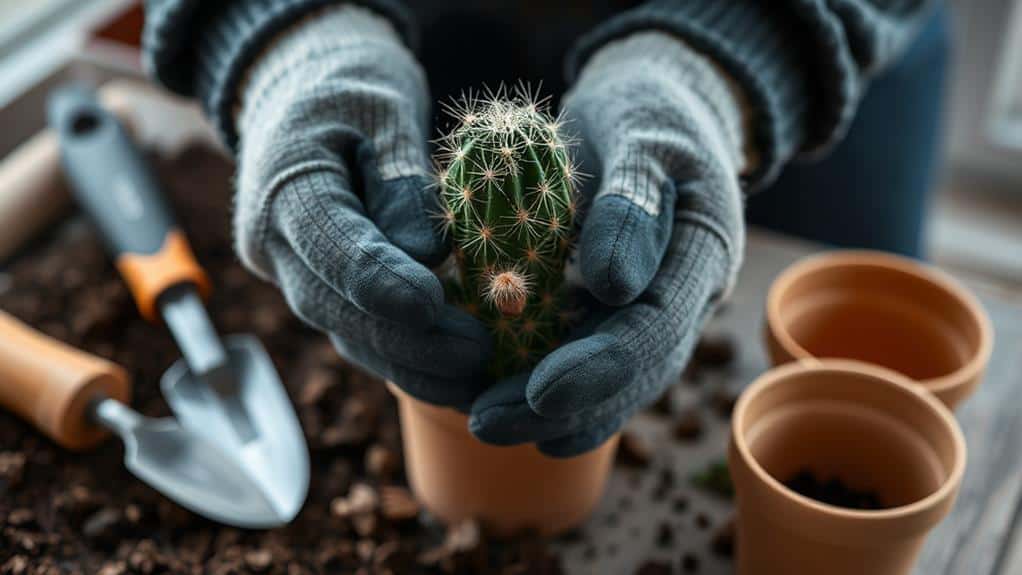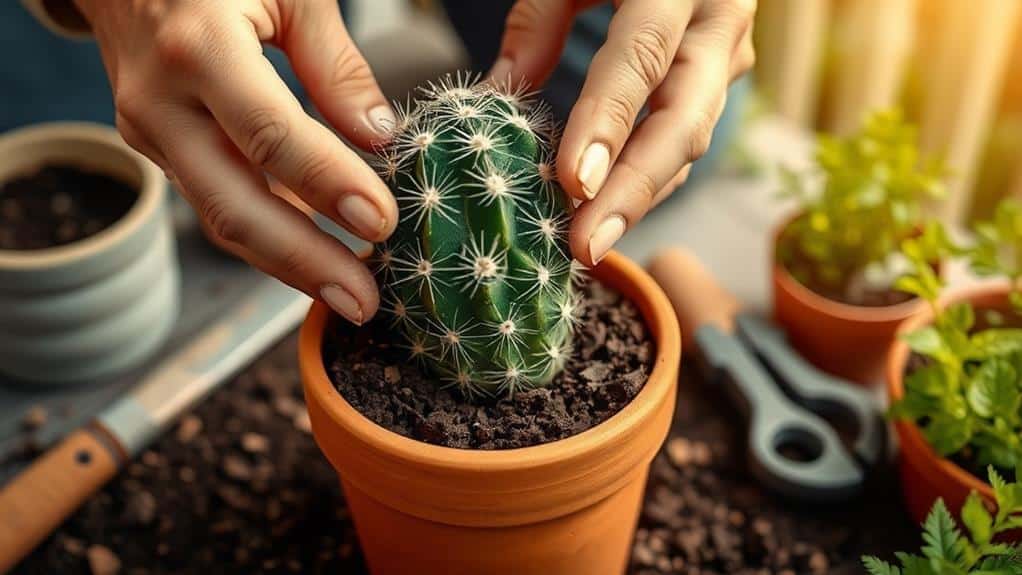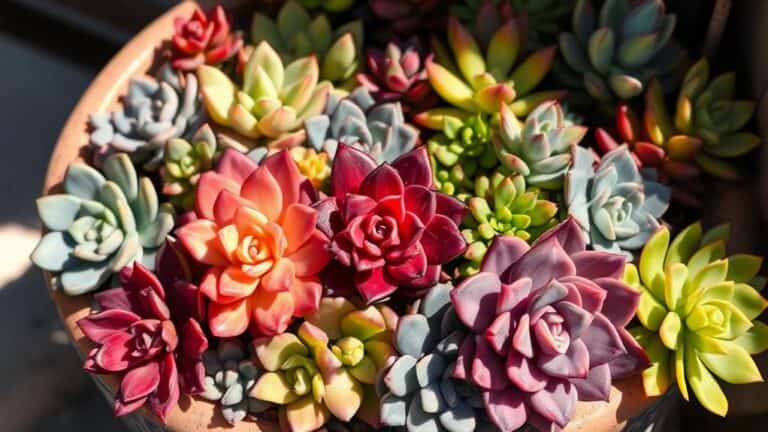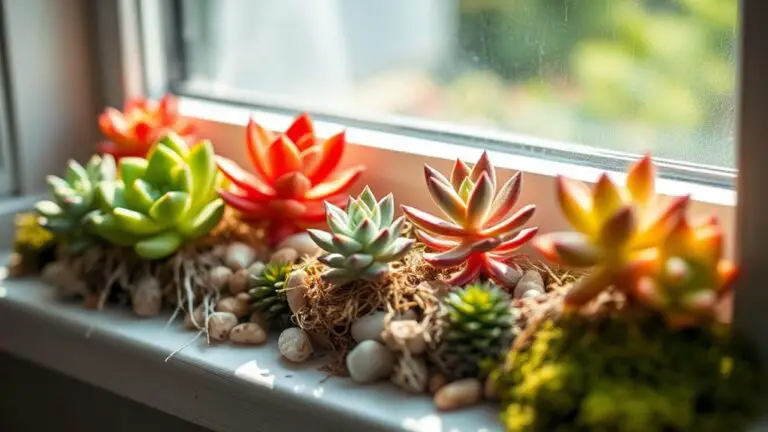How to Repot a Cactus in 3 Easy Steps
Repotting a cactus might seem intimidating, but you can manage it smoothly with a little preparation and care. First, you'll need to gather your supplies, including a new pot with drainage holes, cactus soil, and protective gear to avoid those prickly spines. Once you're ready, the next step involves carefully dislodging the cactus from its current home, making sure you don't damage its delicate roots. But how do you handle the cactus without injury, and what's the best way to settle it into its new pot? Let's explore the details to guarantee your cactus thrives in its new environment.
Gather Your Supplies

Before you start repotting your cactus, gather all necessary supplies to guarantee a smooth process. First, you'll need a new pot. Make sure it's 1-2 inches larger than the current one and has at least one drainage hole. This prevents water from accumulating and causing root rot.
Next, get some quality cactus soil, which is a special potting mix made of soil, perlite, and coarse sand. This mix promotes good drainage and keeps your cactus healthy.
Don't forget to protect your hands. Use thick gloves, preferably leather, to avoid getting pricked by the cactus's sharp spines.
Besides gloves, you'll need some tools. A bonsai rake helps clean the roots, while kitchen tongs are great for handling smaller cacti safely. A metal spatula or dull knife can loosen compacted soil around the roots.
You might also want to have top dressing materials on hand. These can be pumice or limestone, which not only make the cactus look nicer but also help control moisture.
Prepare and Handle the Cactus

With your supplies gathered, you're ready to prepare and handle the cactus. First, assess the cactus's spines and find areas with fewer spines for an easier grip. Wear thick gloves to protect your hands from injury. If you prefer, use kitchen tongs or rolled-up newspaper for extra safety. This will help you avoid direct contact with the spines.
Next, carefully remove any top dressing from the surface of the soil in the old pot. This step makes accessing the cactus easier.
For plastic pots, gently squeeze the sides to help dislodge the soil. If your cactus is in a terra cotta pot, carefully shake it to check if the cactus is loose.
If the cactus still doesn't come out easily, use a metal bonsai rake to carefully detach any roots bound to the pot. This guarantees minimal damage to the root system.
Be patient and gentle to protect the roots during this process.
Repot and Settle In

Start by preparing the new pot with 1-2 inches of fresh cactus potting mix to give the plant a stable base. Carefully remove the cactus from its old pot, using gardening gloves or tools like kitchen tongs or newspaper for safe handling. This will protect you from the cactus spines.
Position the cactus in the center of its new pot. Fill in around the roots with the prepared soil, making sure there are no air pockets. Gently tap the pot on a flat surface to help settle the soil around the roots without disturbing the cactus.
Here's a quick reference table to guide you:
| Step | Action | Tip |
|---|---|---|
| 1. Prepare Pot | Add 1-2 inches of mix | Use cactus-specific potting mix |
| 2. Remove Cactus | Wear gloves, use tools | Avoid touching the spines |
| 3. Position Cactus | Center in new pot | Guarantee stability |
| 4. Fill with Soil | Add soil, no air pockets | Tap pot gently |
| 5. Avoid Watering | Wait a week | Helps roots acclimate |
After repotting, avoid watering the cactus for about a week. This allows it to acclimate and heal any root damage before resuming its regular watering schedule. Following these steps will help your cactus settle into its new home successfully.
Frequently Asked Questions
What Is the Best Way to Repot a Cactus?
To repot a cactus, choose a slightly larger pot with drainage, use a well-draining mix, and water a week before repotting. After repotting, wait 1-2 weeks before watering again to let the roots heal.
Should Soil Be Wet When Repotting Cactus?
No, the soil shouldn't be wet when repotting a cactus. Dry soil minimizes the risk of root rot, helps the cactus adjust more easily, and promotes healthier root development. Wait to water for two weeks post-repotting.
Do You Water Cactus After Repotting?
You shouldn't water your cactus immediately after repotting. Wait about a week to let it adjust and minimize root stress. Keeping it in a well-lit area without direct sunlight helps it recover during this period.
How to Repot Cactus Without Getting Pricked?
Wear thick gloves and use kitchen tongs or rolled-up newspaper to handle the cactus. Loosen the soil with a dull knife, and use cardboard or a towel for extra protection. Experiment with different techniques for the best results.
Conclusion
You've got this! Repotting a cactus might seem tricky, but with the right steps, it's straightforward. Just gather your supplies, handle your cactus with care, and settle it into its new pot. Remember, don't water it for a week to help it adjust. Soon, your cactus will thrive in its fresh environment. Keep practicing and you'll become a pro in no time. Happy gardening, and enjoy watching your cactus grow!







